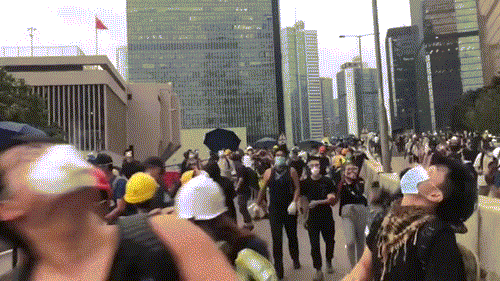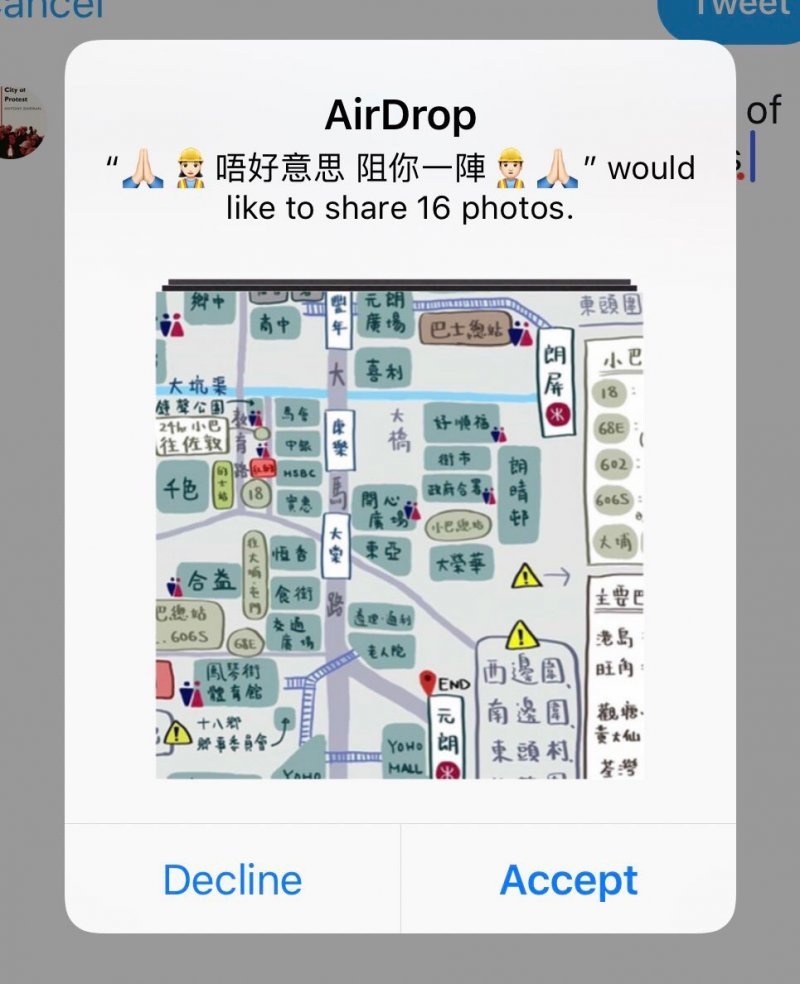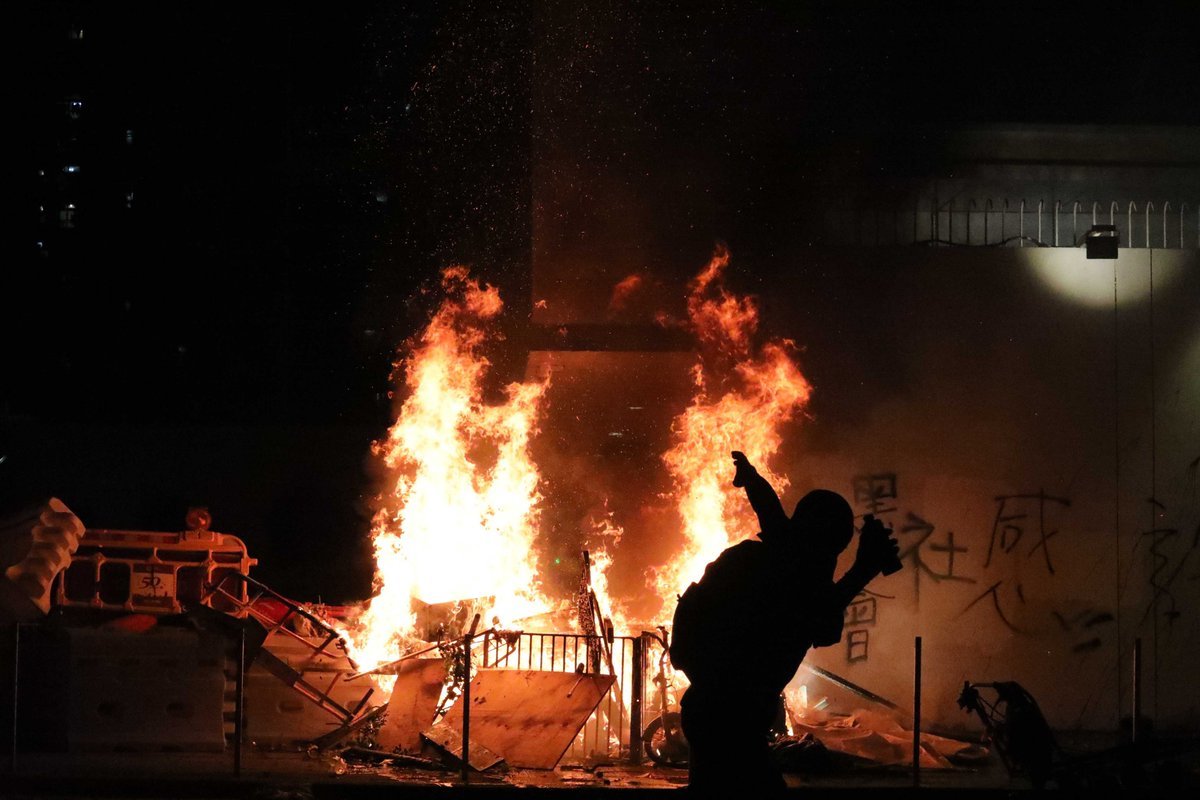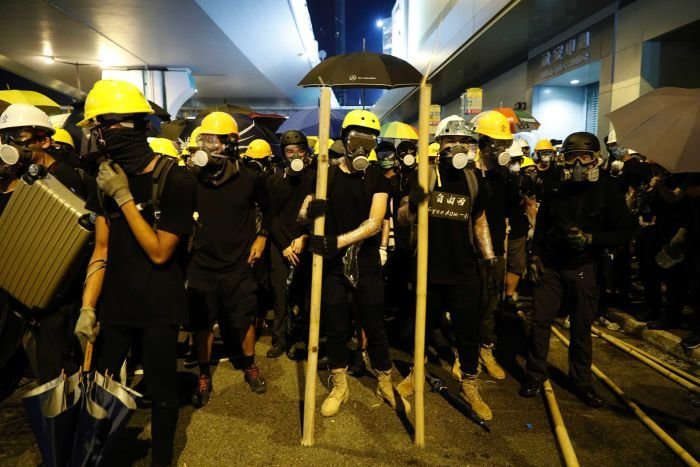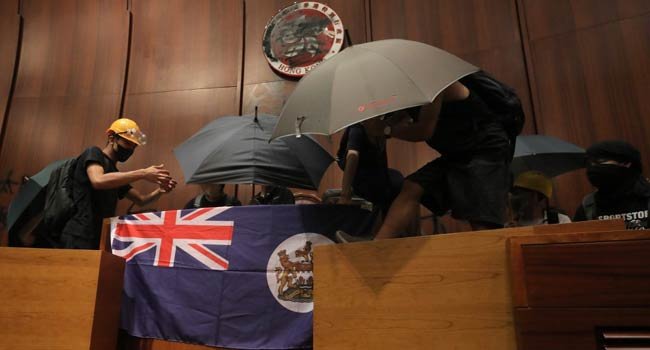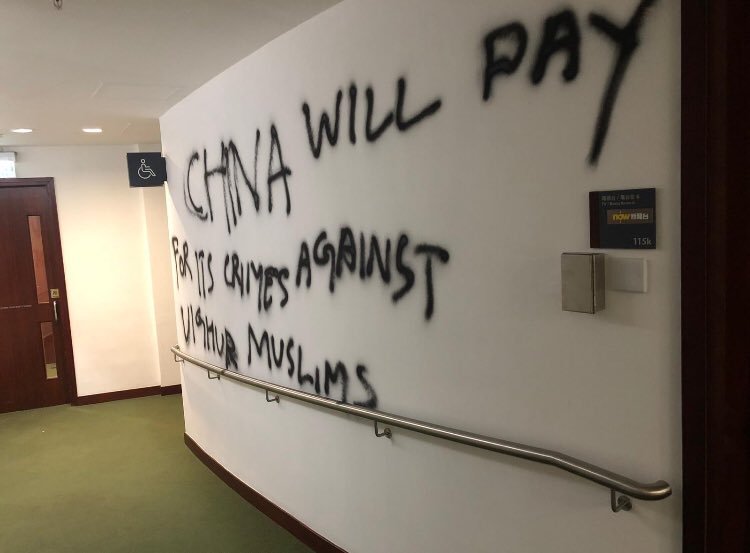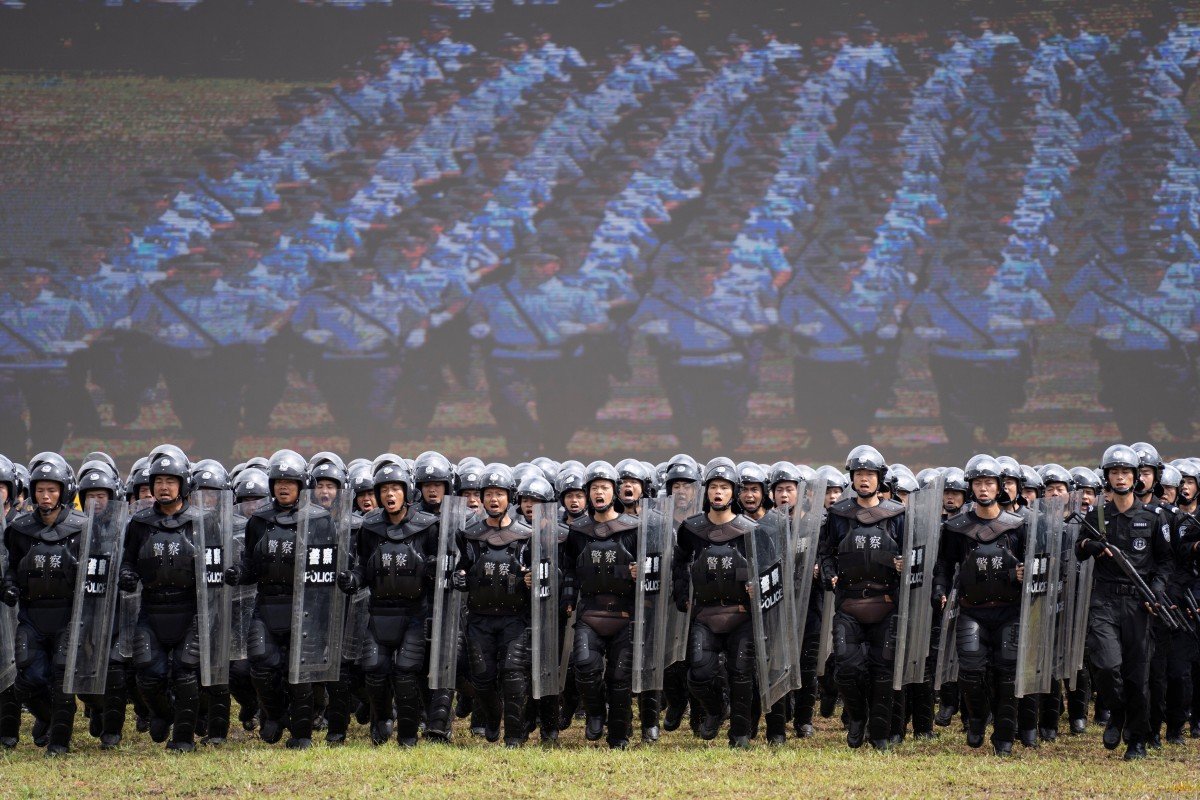Filed under: Featured, International Coverage

A guide to collective and individual tactics being used in the uprising that has been growing in the streets of Hong Kong against the Extradition Bill.
Though the Extradition Bill that brought people into the streets of Hong Kong is temporarily off the table, it seems no other significant demands coming from “the movement” have been met, nor have any pacifying concessions been made. The Police and extra-state forces continue to use traumatizing violence against protesters. Also, heavy sentences for rioting have been handed down to many caught in the fray. In light of all this, there have been reevaluations of what tactics are useful and desirable on the part of the protesters. For the sake of descriptive efficiency, I will problematically elide historical, introductory, long-term strategic, and class considerations for now. I will instead mostly focus on the tactics deployed in the more recent articulations of this struggle.
Demands
Whether or not they know it. The protesters have brought forth demands that are reasonable enough to gain mass appeal, but extreme enough to be impossible for the government to meet fully. They have five core demands; the permanent withdraw of the extradition bill, the release of all protesters from jail, the repeal of the categorization of the protests as riots, the creation of an independent organization to investigate police violence, and perhaps the most daunting demand, universal suffrage. Whether or not these demands hold within them the potential for the movements pacification or co-optation could be the topic of another conversation. There are good reasons why we don’t make demands, but in this instance, it is my opinion that these demands will not be met and will only galvanize the insurgent potential of these movements. These demands may calcify the struggle as a protest movement even as slogans like “Liberate Hong Kong! Revolution now!” reveal a path beyond.
Counter-Measures to Crowd Control Weapons
The black umbrellas that became a signifier of the 2014 “pro-democracy” “Umbrella Movement” in Hong Kong are still everywhere at demos. They block pepper spray and the view of cameras. These umbrellas also were common-place and provided a sense of unity as well as inconspicuousness. However, shields now accompany them in the streets to block rubber bullets and police batons/truncheons. Though they are less conspicuous, they provide better protection and shift the tone to a more active defense.
Protesters extinguish teargas.
Protesters have gotten practice throwing or kicking tear-gas back at the police or away from their group, making sure to wear gloves as the canisters can get quite hot. They have also figured out that water and fire-extinguishers can put out tear-gas canisters, which in turn prevents the canisters from releasing more gas.
A bit of water + traffic cones
This is how Hong Kong protesters extinguish tear gas rounds fired by police #香港 #HongKongStrike pic.twitter.com/UEIVf9QPGn
— Bloomberg TicToc (@tictoc) August 6, 2019
Masks are typical in Hong Kong as the territories air is quite polluted. This allows protesters to conceal their identity and somewhat protects against tear-gas. On top of that, these masks look innocuous before and after actions. However recently more conspicuous gas-masks have appeared which better filter tear-gas. Hardhats have also become common-place at protests where police or extra-state attack is probable to protect one’s head from projectiles and blunt weapons. Goggles are widely used to stop pepper-spray. Saline rap has also been used to provide a barrier for pepper spray, and eye-wash has been distributed to rinse irritants out of eyes.
Communications
“Gongs and drums, banners and flags, are means whereby the ears and eyes of the host may be focused on one particular point. Thus the host forms a cohesive body.”
– Sun Tzu, The Art of War
The protesters are using a lot of digital communication to coordinate. They use LIHKG, something like Hong Kong’s Reddit, to spread discourse and movement news. Tens of thousands are in encrypted Telegram groups that take polls and announce actions. Encrypted Whatsapp groups share choice photos. The Airdrop function on iPhones is now a tool for digital-fliering. Much of the communication to the “outside world” has happened via mainstream media outlets and Twitter.
A map sent to protesters in the area via airdrop. Photo credit: Antony Dapiran
A form of IRL communication that the movement has spread all over the world is “Lennon Walls.” These walls are trapping of Hong Kong’s 2014 “Occupy Central with Peace and Love.” They replicate a free wall in Prague that bears hippie-dippy messages and Beatles quotes only now it takes those things coupled with an orientation around the “Umbrella Movement” and the current struggle. These “Lennon Walls” have popped up all over and have become contentious sites often coming under attack, but serve as an IRL place for inspiring messages, self-expression, relevant information, and so on.
Protesters signal a request for helmets.
As they do things together more and more, communication becomes paralinguistic. Subtle gestures, bodily movements, and so on create ripples in their shared body. When the tear gas comes, they immediately contain it. When a firework is thrown at them, they give it sufficient meters of distance. When the police charge they rush to meet them or withdraw, but most importantly, they do it together. They have become accustomed to moving as a body.
Inspired by the police’s black, orange and red warning flags, #hongkong protesters also come up with their own set of flags to direct the crowd to ‘go forward’, ‘back away slowly’ or ‘stop’. This makes communication much easier #hongkongprotests #antiELAB pic.twitter.com/iX5XMMHwdK
— Jeffie Lam (@jeffielam) August 4, 2019
Communication can be vital in acting cohesively, whether it’s communicating general goals that allow a movement to operate effectively or conveying things to a crowd of thousands so that they may move together. Chants of “One! Two! One! Two!” are used to prevent stampeding during retreats. Flags are used to signal group activity.
Distribution
Being close to manufacturing points makes it easier to get cheap supplies in bulk that has allowed people to get their hands of equipment and materials without having to have everyone go out and buy them on their own. Demos have become sites of distribution of materials and supply lines are a feature of most significant protests where clashes with riot police are assured. Human chains pass supplies to the front lines of conflicts. Supplies commonly distributed at demos, all with their own hand signs; zip-ties(to secure barricades), pliers, umbrellas, shields, water, saline solution, goggles/safety glasses, barricade materials, masks, asthma inhalers, markers, plastic wrap, and allen-wrenches. These supply lines also provide a way for those who are unable to fair well in frontline clashes to support the front line and make the frontline possible.
Protesters pass a helmet to where it’s needed along a human chain having seen the hand singals of people in the front. Photo credit: Tyrone Siu
Some who cannot stay long at the protests hand out water. Some leave bags of clothes around so that people can change in a hurry if needed. Others convert their stores into “protest kit” vendors selling needed supplies for cheap, a questionable tactic but one that has helped the facilitate distribution none the less.
Lastly, part of the reason these supplies are easily obtainable is HK proximity to the sites of production.
Leaderlessness
All the major protest leaders from the “Umbrella Movement” are sitting in jail or have stepped down. Out of need and wisdom, planning and announcements have become dispersed and decentralized. There are crews of front line fighters and strategists who plot together. There are dozens of online groups where plans are hatched, and calls made. With no single head to cut off the security forces have a harder time repressing the movement.
Smashing, Clashing, and Abandoning Self-Policing
Uncivil activity like vandalism of government property and attacks on police are increasingly supported. These things were almost unheard of during “Occupy Central with Peace and Love” and there was intense intra-movement policing surrounding such matters. The 2016 street battles of the “Fishball Revolution” that followed the repression of 2014 movement were the first galvanized manifestation of attacks on police and creative engagement with street fighting tactics. Now Communist Party symbols are iconoclasted, rocks rain down on police, and police stations are besieged regularly.
The undoubted arrival of Hong Kong’s version of kale borroka.
Making it Personal
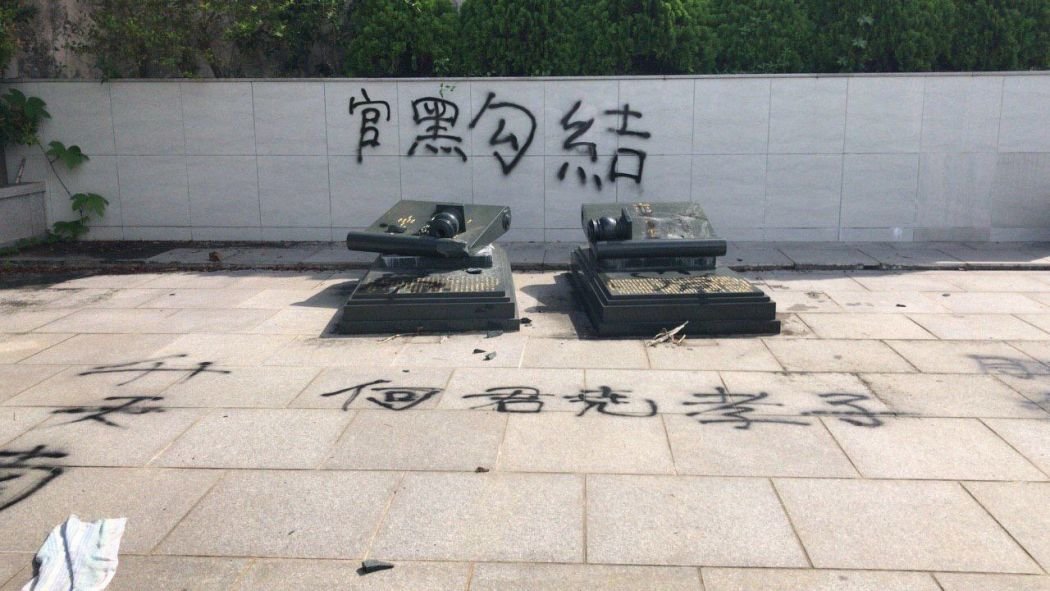 Graves belonging to the parents of a “pro-Beijing” legislator, alleged to have shaken hands with the white-shirts who attack a protest, were desecrated and vandalized with anti police slogans.
Graves belonging to the parents of a “pro-Beijing” legislator, alleged to have shaken hands with the white-shirts who attack a protest, were desecrated and vandalized with anti police slogans.
Leaks of Police information have lead to targeting of cops’ houses and fliers being put up in neighborhoods where officers live.
Regarding the personal data leakage concerning Police officers & their families, & the public order events in the coming few days, Superintendent Louis Lau Siu-pong has the following messages.
就警務人員及家屬個人資料於網上被披露,及未來數天公眾活動的消息,劉肇邦警司有以下訊息。 pic.twitter.com/aJuF402QcX— Hong Kong Police Force (@hkpoliceforce) August 1, 2019
Lasers
Protesters have also used lasers to blind cops and block cameras. They simultaneously provide pleasing aesthetics. I should note that they’re also using not only the dangerously powerful green lasers but also the terrifyingly powerful blue lasers. The closer you get to purple on the rainbow spectrum the more powerful the laser.
These lasers Hong Kong protesters are pointing at riot police through billowing tear gas, it's like something out of a sci-fi movie. #AntiELAB pic.twitter.com/noTllDuc09
— Alejandro Alvarez (@aletweetsnews) July 28, 2019
Come Together Leave Together
Buddy systems are encouraged as police have picked people off after events.
Go Against the Flow (of Traffic)
Protesters have learned police vehicles can’t follow them as well if they go against the flow of traffic in the streets because cars on the road block their advance.
Barricades and Blockages
Barricades block the flows of traffic, are used to hide from projectiles, and slow the advance of the police. Commuter trains are blocked to cause economic and social pressure. Airports too are shut down by sit-ins. Masses of people disrupt the functioning of government offices. Much of these actions cause the most damage to government and capitalist logistics and are also some of the less dangerous activities to attend, as opposed to police station sieges. Hong Kong is a point major of circulation for China. If Hong Kong’s flows are congested, the Chinese Communist Party feels it and thus the world’s markets also feels it.
Non-cooperation action also happening at North Point mtr on Hong Kong island line. Protesters stopping trains from closing & leaving and chanting anti-police slogans #HongKongProtests #antiELAB @SCMPNews pic.twitter.com/yX0lah14wm
— Linda Lew 刘凌达 (@Lindadalew) July 30, 2019
Maneuvering
Another trapping of “Occupy Central” shed by the “Umbrella Movement” is the “permanent occupation.” Instead of taking territory and trying to defend it, they opt for roving occupations, mobile crowds, and pop up demos. Some still dig in their heels to fight with the police, but many swarm a logistical node till it shuts down then move on. They are not afraid of tactical retreats. After all, why fight would they need to fight the police at a disadvantage when you can outpace them and still disrupt business as usual and chuck stones at them from afar?
Counter-Surveillance
The police, of course, have spies in the movement, but the protesters have lookouts watching and communicating police movements. Likewise there are sympathizers in the state and informants or “ghosts” within the protest. Many protesters however have stopped worrying so much about “ghosts” and just let people do what they will while generalizing security tactics and effective means.
Black Blocs?
There’s much debate if you can call protesters who wear all black and masks a black bloc. Some who participate intentionally call it that, but they are admittedly a small number. Whether or not a bloc or not, the protesters wear all black and similar gear to create a sense of unity and make it harder for people to pick them out of the crowd.
A group of protesters wearing typical protest garb including lots of black accented by their yellow helmets.
Extra-State Violence
Armed men have attacked the protests. This tactic allows for those defending the ruling order to use violence that otherwise wouldn’t be socially viable or to create a unique sense of terror in those attacked. Just like police attacks on protests, it is meant to scare people out of the streets. Though this tactic, of course, had some intended affects, it also pushed many to come out in anger and to pick up street fighting tactics. The men all wore white shirts and received tacit support by legislators, which made the event useful for the protestors as it was a memorable event. There was also a drive-by firework attack on a group of protesters who were surrounding a police station that proved to spread rapidly online and garner even more support.
A protester separated form his non-cooperation-action group and attacked by white-shirts.
There are rumors that the white shirts were triads serving their political interests. Triads are specific criminal organizations that come out of Macau, Taiwan, and Hong Kong but have a presence all over the world. As the New Territories, where the attack by the white shirts took place, increasingly urbanize triads have increasingly melded with the political establishment.
There have also been attacks on “Lennon Walls” and pro-movement rallies by the Communist Party of China supporters in other countries. The more recent attacks by armed men in Hong Kong, however, have been far less successful and have been met with a rain of random objects and angry youth who have cut their teeth in street clashes.
Moments after this more recent attack the white-shirts retreated and some were cornered and badly beaten.
International and Alternative-Colonial Appeal
Those protesting for Hong Kong’s autonomy have often tried to appeal to outside powers. Sometimes these appeals are as palatable as appeals to Hong Konger communities abroad to the odd valorization of colonial connections to the United Kingdom. Protesters often fly flags from the era when Hong Kong was a British colony and sometimes British flags themselves. Likewise, Taiwanese flags have also made plenty of appearances as an attempt to unite the struggles the to regions face against “sino-Subjugation.”
It is perhaps important to note that after the civil war the Chinese Nationalists and reactionaries who had been backed by the Nazis and later the United States to fight the Communists and their allies fled to Taiwan and their symbol still adorns the Taiwanese flag. American flags have also been spotted at protests, much to the delight of those who wish to paint the protests in Hong Kong as CIA operations, but also as a sort appeal to democratic colonial revolution. The US flags also are probably an appeal to US assistance in their struggle as the US has in the past given crucial support to uprisings in territories controlled by their economic rivals. Geopolitical tactics and appeals to sovereign powers have proven to be affective in previous national-autonomy struggle and revolutions. Problematic or not, these symbols have appeal and power. It is also the case that, early on, targeted crowd funded ads were sent out in major news papers asking G20 participants to support their cause.
Hong Kong’s flag from the British Colonial period is raised in the trashed main legislator building.
Recently Trump has mimicked the rhetoric of the Chinese state calling the protesters rioters and calling Hong Kong China’s business. The appeals to America have dwindled, but the appeals to the American Revolution have increased as far as we can tell. Invoking a revolutionary continuum is a powerful tactic.
We’ve spotted an invocation of both the Boxer Rebellion and the American Revolution made by this Combo of the Qing Dynasty flag and the Gadsden flag circulated by HK supporters online.
The main thrust of the international networks and solidarity actions reside in British commonwealth countries. This is in part due to Hong Kong’s historical colony-status simple making a lived reality where Hong Kongers have connections to these countries because they lent themselves to travel between each other as British domains. On the other hand, there have been appeals to Anglo-sensibilities. As time moves on it seems clear that the governments of the world don’t care to help tho the support of worldly Hong Kongers and their Anglo fellow-travelers seems bolstered every day.
Localism, Nationalism, and Social Cleansing
The most militant elements of this protest movement and perhaps the most popular feature that wants to push beyond reform into a revolutionary break are regrettably nationalist and localist elements.
The desire for national autonomy, like any autonomy, should not be underestimated. Wanting freedom, after all, is a powerful want. Though we should also we wary of the continuing appeal of nationalism.
Protesters spray-painted the Golden Bauhinia Square in Wan chai with the words “the heaven would destroy the communist party“ and “liberate hong kong” #hongkongprotests #antiELAB pic.twitter.com/JuL2e2lMYK
— Jeffie Lam (@jeffielam) August 4, 2019
Hong Kong also has a culture and community that is indeed worth defending, but it’s capitalism not immigrants that are the biggest threat to it. Thus preserving the desirable cultural infrastructure of Hong Kong via xenophobia that cozies up with neoliberal business is a tactical dead-end.
Also present are the bourgeois or nigh-fascist appeals to cleansing and scape-goating downtrodden members of society. In this case, it manifests in racism and xenophobia against mainland Chinese people, often beggars or park goers, or working-poor South Asian migrants (though it often includes tourists as well).
From the early days of the 2019 protests, the signs read “Strict enforcing of law against smugglers of grey goods.”
Though the nationalist and localist narratives are falling by the wayside, the implicit cultural attitudes and xenophobic foundations are still present. When concessions are granted, or the crack-down comes, there’s a good chance opportunity will strike for the nationalists to try and gain public or at least militant support. Currently though, having been heavily targeted by heavy state repression, it seems the nationalist’s core rhetoric hasn’t been able to survive outside the green-house of their more underground networks.
The “pro-Beijing” forces also engage in sorts of localism and nationalism. They claim that those attacking the protests are locals and accuse non-ethnic-Chinese (mostly white people) of being outside agitators or CIA assets.
State officials hold up and image of a white expat supporter of the protests.
These accusations have back-fired and gotten large sectors of the movement to embrace non-ethnic-Chinese supporters of the movement in their propaganda. Of course, some of this holds colonial trappings, but it has also gone beyond that. Tourists, mainlanders, and migrant workers have been reached out to by the movement in unprecedented ways. There are also attempts to bridge Hong Kong’s struggle with struggles in the mainland.
Graffiti on the wall of a government building shut down by protesters denounces state-repression of an ethinic minority in China.
There is also something to having a territory to defend. A place to root yourself in. A place that holds in it a multitude of desirable relations. It is possible for a rebellion to be around one people or place in particular, but for “all people” in general. While dangerous localisms and odd alternative colonialisms remain. There are also new interconnected paths of struggle opening up.
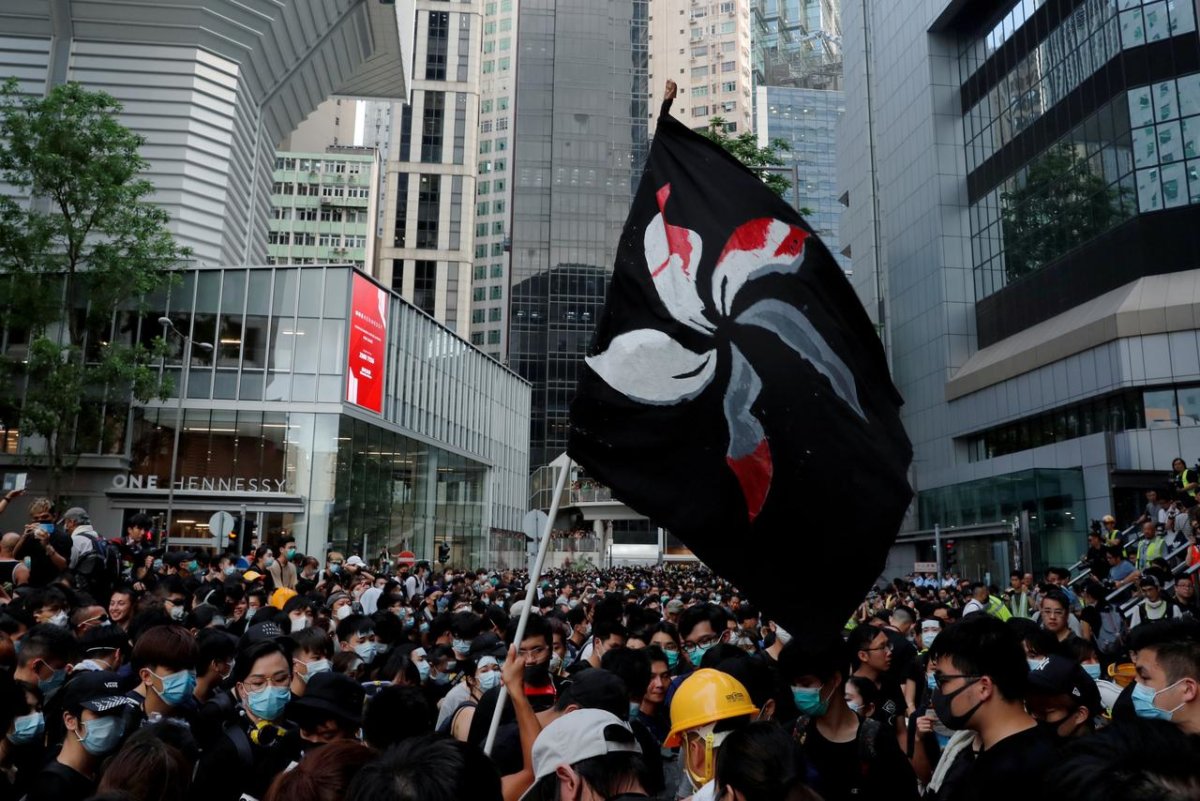 A new flag has emerged in this years clashes; it is Hong Kong’s orchid flag, but struggle has turned it from red to black.
A new flag has emerged in this years clashes; it is Hong Kong’s orchid flag, but struggle has turned it from red to black.
One tactic that perhaps shows a positive side of localness is taking it to the neighborhoods. There the protesters can get support from the residents in the form of supplies and places to hide. Some have even given out pin codes to apartment complexes so people can find shelter in emergencies. Whether intentional or not, the police violence has also affected these residential areas in such a way that the locals have turned against the police in not insignificant numbers.
State and Police Tactics
It’s not only the protestors that are better prepared for street clashes. The Hong Kong police have upgraded their equipment. With better armor, more weapons, and better training they’ve managed to break up many protests and enforce the ban on anti-government assemblies.
Riot police in a demonstration of force on the mainland side of the HK-Shenzhen.
The Hong Kong Police Force has been training hard since 2014 and even more so after the “Fishball Riots.” Their raptor units have excelled at shattering groups of protesters and grab whomever they can. Their top of the line riot gear and proper use of shields make and blunt weapons break over them like waves on rocks. The police also have their eye on logistical choke points and have targeted train stations they know protestors will use. The state has escalated the use of harsh sentences for protest making people think twice before taking the street. They use flashlights to temporarily blind protesters and block cameras.
As tensions in Hong Kong flair, the Chinese government has broken their silence both in condemning “criminal violence” in Hong Kong as well as via great shows of military/police force. And Hong Kongers know with the high-speed rail the PLA could be in their streets at the drop of a hat, but whether or not that is socially viable or not is a different story. Just as on the frontiers of the United States having local powers deal with insurgencies is usually more effective.
The Chinese state does practice soft power. Soft power is how it has maintained Hong Kong as a territory out of which it sucks capital. But in plenty of cases, as many in mainland China can attest, they also are no strangers to brute force. They roll tanks into fishing villages protesting industrial dumping. They crush strikes via cracked skulls. They round up and send ethnic minorities that have affiliated extremist groups and put them in camps.
Electoralists and counterinsurgency experts agree: Revolutions cannot be suppressed. But they can be channeled.
— Inhabit (@inhabitglobal) August 1, 2019
Recently, as opposed to denouncing all protests, the state engages in “good-protester vs bad-protester” rhetoric. It does this in part by suggesting passive ways of protesting and decrying more effective direct action and clashes. Whereas before the state had to condemn all protests.
Mark: “We are not causing chaos. We want to tell people what Hong Kong has lost, and we want it back!” #antiELAB #hongkongprotests #ABetterTomorrow #英雄本色 https://t.co/7iEPMq6FpM pic.twitter.com/b3OY3J99tT
— Vivienne Chow (@VivienneChow) July 31, 2019
The Strike and Support Networks
The General Strike called for by the movement on the 5th of August was more than a strike. It was in part a successful refusal of work by aviation workers, finance workers, civil servants, and many more. It was also, however, a massive campaign of logistical blockage. Roving crowds shut down streets, government buildings, trains, and much more. People took over malls and turned them into air-conditioned rally centers. Hundreds of flights were canceled. Police stations were besieged. Street-fighting went into the night. The city was disrupted on a massive scale.
There were some interesting nuances. The pairing of disrupting travel logistics with the call for a strike became phrased as “liberating people from work.” Protesters gave many an excuse to skip work or come in late making it hard to discern active participants in some cases. It is also true that it only took several hundred to shut down some of the most significant nodes of transportation — several hundred being a relatively small number in terms of Hong Kong’s population.
The Strike itself in its propaganda and in its operations highlighted how everyone, not just frontline fighters, are vital to this struggle. The protesters have highlighted how the frontline cannot exist without social and infrastructural supporters. Similarly many protesters have gone out of their way to be kind to the everyday people they who use the logistics they are disrupting while still effective disrupting said logistics.
Generalization of Generalized Creativity
Engineers send out barricade blueprints, hackers shut down metal doors at transport centers, construction workers bring work equipment, and people see themselves as creative participants in the movement. The reproducibility of tactics is important, but often this is seen as reproduction of a single tactic rather than inspiring people to reproduce a myriad of unique tactics each tailored to their own affinities and skills. Of course specific reproducible tactics are important, but magic can happen when people are inspired to intervene in ways only they can intervene.
Conclusions
What we have written here is, perhaps obviously, not a blanket endorsement of these tactics, especially not outside of the context of Hong Kong’s particular social, legal, and material terrain. Hong Kong is on its way to being a megacity, after all. We have attempted to make these things visible so that we may critically engage with them and think of them in relation to our operations and maybe find inspiration for struggle in our own context. I agree with the statement “we would redirect attention to the radical possibilities opened up whenever hundreds of thousands of ordinary people disrupt the everyday socioeconomic order and try to take matters into their own hands.”
It is also fair to say that this an alienated account biased by excitement and tactical affinity. We have only a few friends of friends in this struggle, but their experience is similar. They say that many of the youth there on the streets too are alienated and effectively motivated. This is an analysis from on high rather than from boots on the ground. It is has also been rushed so that it arrives in your feed while things are still topical. In certain ways this movement has made the jump from protest to revolution. There is clearly a deadlock and with deadlock comes potential energy that can result in social rupture.
It is quite possible for tactics to over-ride whatever less-than-desirable strategy they are supposedly serving: the lived practice of street activity can make anarchists out of liberals and insurgents out of democracy stans. It is also true that tactics can be used for various goals. Fascists and their ilk also engage in street fighting even against cops. The NATO/EU/US-aligned “color revolutions” being funded by the state and the right in the US is a real thing, as well. What is interesting to us here is not the overall geopolitics, but rather the immanent tactics used to block the flows of commerce and governance that make us feel as if we could be there along side them.


